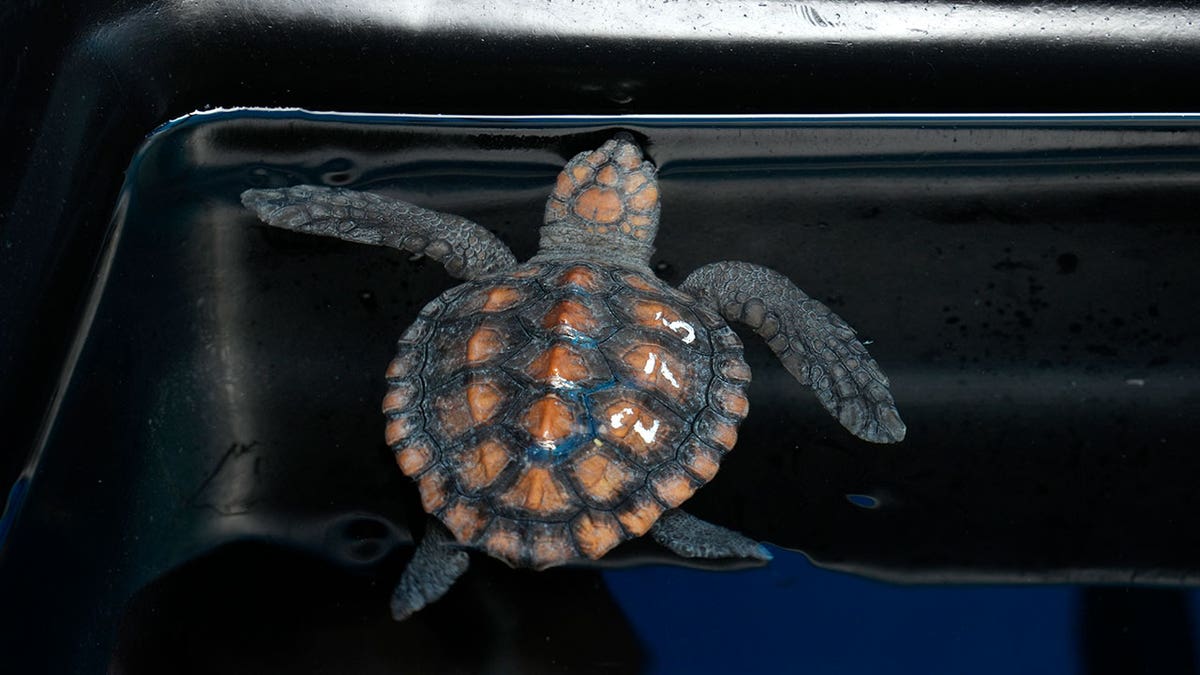Thirty-four sea turtles return to the ocean in Georgia after rehabilitating for months
A few dozen sea turtles were released back into the ocean after going through rehabilitation programs over the last few months. The turtles were taken to Jekyll Island in Georgia for the big moment.
- Over 500 baby sea turtles, mainly endangered loggerheads, have been rescued in Cape Town after a rare storm.
- The Turtle Conservation Center is rehabilitating around 400 turtles, while sending the rest to two other aquariums to spread the load.
- The baby turtles were likely swept from the northeast coast to Cape Town by the Agulhas Current.
An aquarium in South Africa is stretched beyond capacity after more than 500 baby sea turtles were washed up on beaches by a rare and powerful storm and rescued by members of the public.
The little turtles are mostly endangered loggerheads and should be cruising the ocean. Most of them instead will spend the first few months of their lives in newly built plastic tanks at the Turtle Conservation Center at the Two Oceans Aquarium in Cape Town. The aquarium is rehabilitating around 400 of the roughly 530 sick and injured turtles that were brought in, while sending the rest to two other aquariums to spread the load.
Baby turtles have to fend for themselves from the moment they hatch on beaches and make their way to the ocean.
In South Africa, loggerheads hatch on the northeast coast on the far side of the country from Cape Town. These turtles were likely sucked in by the warm Indian Ocean Agulhas Current, carried around the tip of South Africa and spat out in the cold waters of the Atlantic Ocean near Cape Town.

A turtle hatchling is seen at the Turtle Conservation Centre at the Two Oceans Aquarium in Cape Town, South Africa, on April 23, 2024. (AP Photo/Nardus Engelbrecht)
That's fairly common, said Talitha Noble-Trull, the head of the Turtle Conservation Center. She's in charge of treating the new arrivals.
What isn't normal is the powerful storm that recently hit the Cape Town area, leaving hundreds of baby turtles needing help.
The conservation center usually receives a few to maybe 100 stranded young turtles in the three to four months after hatching season. It has a normal capacity of 150 turtles.
"What we haven’t seen before is over 500 turtles in two weeks, which is what the last little bit of time has brought us," Noble-Trull said. "My budgeting plans for the year have really gone out the window."
US SEES RECORD SEA TURTLE NESTING, RAISING CONCERNS ABOUT CLIMATE CHANGE THREATS
She estimated that each turtle will cost $500 to get back to full strength before being released into the warmer Indian Ocean in a few months. The Turtle Conservation Center has brought in a small army of volunteers to help the aquarium's full-time staff care for them.
The turtles are ranked according to how sick they are, with some needing intensive care due to injuries, malnutrition or infection. A number is written on each shell to identify them.
While the storm was a major shock to the turtles, who are vulnerable to extreme weather and climate change, it has given Noble-Trull and other conservationists a valuable insight into another increasingly common danger.
CLICK HERE TO GET THE FOX NEWS APP
Many of the turtles had ingested small pieces of plastic, which exited their systems after they arrived at the aquarium. Noble-Trull has a tray of plastic pieces collected in just one day, some as big as a fingernail.
The conservation team normally wouldn't see that amount of evidence of plastic pollution in the ocean.
Turtles spend almost all their lives in the ocean, apart from when they're born and when females return to shore to lay eggs. Because of that, they're "ocean indicators," Noble-Trull said.
"Little bits of soft plastic, little bits of hard plastic are floating all along the oceans and turtles are eating them. So, for us it’s very important to be collecting and capturing this data. Because these turtles are coming at us with a message. They’re not telling us. They’re shouting it at us. That our oceans are not a safe place for turtles."
